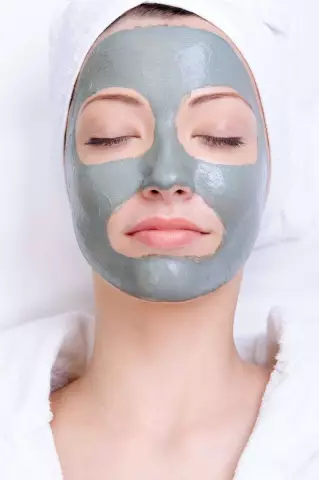- Author Rachel Wainwright [email protected].
- Public 2023-12-15 07:39.
- Last modified 2025-11-02 20:14.
Effects of dietary mistakes on the face: 4 types of aging
It's no secret that age is reflected on the face. But aging is not the same for different people. Recent studies have shown that age-related changes in the face depend, in particular, on what foods prevail in the diet. Knowing how a passion for a certain food affects your appearance, you can correct the mistakes made in nutrition and look younger and healthier.

Source: depositphotos.com
"Wine" face
In this case, we are not talking about those who abuse strong alcoholic beverages. Many people think that a glass or two of good wine is perfectly acceptable to relax after a busy day.
The faces of people with this habit are characterized by:
- redness of the skin between the eyes;
- dry skin;
- pronounced mesh of capillaries on the cheeks;
- redness of the nose and cheeks;
- premature deepening of the nasolabial folds;
- expansion of pores;
- overhanging of the upper eyelids.
The fact is that with the regular use of alcohol, the skin is dehydrated and the collagen, which provides its elasticity, is rapidly destroyed. Ethyl alcohol and its decay products inhibit the production of substances with which the body fights inflammatory processes. As a result, redness appears on the skin. In addition, constant alcohol intoxication (albeit not intense) does not allow the delicate walls of the capillaries to fully restore their tone. They remain stretched, which is manifested in the form of a noticeable "cobweb" on the face.
Regular consumption of small doses of alcohol puts an increased strain on the liver. A sign of "fatigue" of this organ is the purple tint of the tongue surface.
A person whose face is aging according to the "wine" type is recommended a three-week break in drinking alcohol, and then it is necessary to minimize the habitual libations as much as possible. With a similar reaction to alcohol, it can be consumed no more than once a week, giving preference to natural wines with a low sugar content.
Sugar face
Not everyone strictly controls the consumption of the so-called fast carbohydrates. This is usually only concerned about those who suffer from metabolic disorders or seek to lose weight. And the sweet tooth may experience the following signs of facial aging:
- emaciated appearance;
- spots and pimples;
- deep horizontal wrinkles on the forehead;
- pallor and thinning of the skin;
- grayish tint of the integument of the skin;
- bags under the eyes.
An excess of sugar in the diet triggers the glycation process: glucose and collagen molecules attach to each other. As a result, collagen loses its flexibility and elasticity. The facial skin sags, wrinkles and bags appear. Excess sugar alters the normal distribution of subcutaneous fat. Therefore, the face of the sweet tooth loses its roundness, it seems emaciated.
A diet rich in refined carbohydrates has a negative effect on the beneficial intestinal microflora. This creates the prerequisites for the development of pustular processes on the skin. Sweet lovers often have pimples on the face, chest and shoulders. Finally, the consumption of large amounts of carbohydrates forces the body to produce insulin, which leads to premature depletion of the adrenal glands. Their poor condition is manifested by an earthy complexion and thinning of the eyebrows.
If your face is aging like a sugar type, you need to radically change your eating habits. Avoid foods that contain refined carbohydrates (baked goods, cakes, cookies, fast food, etc.), and opt for fresh fruits and vegetables. This will help to stop negative changes in the body and improve your appearance.
"Milky" face
Milk is a unique natural product containing most of the substances necessary for our health. This is why many people believe that neither whole milk nor foods such as cream, yogurt or cheese can harm humans. Unfortunately, this is not the case: over the years, the body largely loses the enzymes involved in the digestion of lactose. Failures in its processing are reflected as follows:
- dark circles and bags under the eyes;
- swollen upper eyelids;
- uneven skin on the chin;
- whitish pimples and spots on the lower part of the face.
Milk contains many biologically active substances. These are not only natural ingredients, but also components that are used to maintain the health of cows (antibiotics, antifungal and anti-inflammatory drugs). In women who prefer a milk diet, such a "cocktail" often provokes a violation of the ratio of progesterone and estrogen, a failure of the hormonal background, which affects the condition of the face. In such cases, it is worth giving the body a break from dairy products. A three-week break from their use usually provides a noticeable positive effect.
"Gluten" face
Complete gluten intolerance (celiac disease) is a rare autoimmune disease, but in those who do not have it, too much gluten can cause continually recurring inflammation. In addition, gluten affects the cells that are responsible for skin pigmentation in our body.
The face of a person whose body does not tolerate foods saturated with gluten becomes puffy, the cheeks turn red and look swollen. Excessive pigmentation appears on the chin and temples. Such changes in appearance require the rejection of dishes containing processed products of barley, rye and wheat. It is also useful to enrich the diet with vegetables and fruits - foods rich in fiber. This will help relieve puffiness and improve blood composition, which will have a beneficial effect on the shape and color of the face.
The body's response to substances supplied with food is individual. The type of facial aging depends not only on mistakes in nutrition, but also on the specifics of metabolism. Nevertheless, it makes sense to evaluate your own appearance and, in the presence of negative changes, adjust your usual diet accordingly.
YouTube video related to the article:

Maria Kulkes Medical journalist About the author
Education: First Moscow State Medical University named after I. M. Sechenov, specialty "General Medicine".
Found a mistake in the text? Select it and press Ctrl + Enter.






